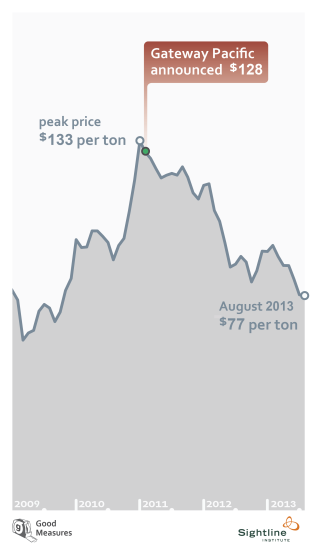The collapse of the Pacific Rim coal bubble has put all West Coast coal export plans in jeopardy. But no company has more to lose from the price collapse than Peabody Energy, one of the main proponents of the proposed Gateway Pacific coal export terminal in Bellingham, Washington.
If the Gateway Pacific terminal existed today, Peabody would lose roughly $10 for every metric ton of coal the company tried to export through the terminal. If Peabody tried to utilize the full 24 million metric tons of annual capacity the company has reserved at Gateway Pacific, the company would lose about a quarter of a billion dollars per year in cash—and would rack up additional losses for capital expenses, depreciation, and mine depletion.
Peabody Energy’s Powder River Basin coal mines face three key vulnerabilities in today’s market:
- Low quality coal. Compared with better-positioned domestic and international competitors, Peabody’s Powder River Basin (PRB) coal mines produce coal with relatively meager energy content, which reduces the price that the company’s coal can command in international markets.
- High transportation and handling costs. The cost of a 1,600-mile rail trip to the Gateway Pacific terminal, plus coal handling and ocean shipping fees, undermines the competitiveness of Peabody’s PRB coal.
- Low-cost competitors. To succeed in international coal markets, Peabody must compete with well-established international rivals, many of whom produce higher quality coal with lower costs.
Peabody’s coal export strategy now amounts to a bet that the Pacific Rim coal bubble will re-inflate, and stay inflated indefinitely. Given recent price trends, the oversupply of thermal coal from Australia and Indonesia, and steps by China to trim coal demand, this amounts to a risky, uncertain bet on future price trends.
Peabody Energy, Gateway Pacific, and the Asian Coal BubbleCare to comment? The report is also featured on our blog.







